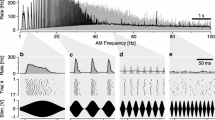Summary
-
1.
Physiological characteristics of single, primary auditory units have been examined in a member of the Orthopteran family Stenopelmatidae.
-
2.
Individual units are tuned more sharply than the whole auditory organ. Units have peaks of sensitivity within the bandwidth described by the summed threshold curve of the auditory organ.
-
3.
Some units display one or two additional peaks of sensitivity at higher frequencies, which may not be harmonically related to the major peak.
-
4.
Units respond to tones with a tonic discharge in which an initial, partial adaptation may occur. Stimulus intensity is coded in terms of spike rate and latency and units display typical, sigmoidal input-output curves. High intensity suppression of the response is sometimes observed.
-
5.
Repetition rates of brief sound pulses that units can follow are limited by mechanical and/or physiological aspects of the sensory process. Minimum latency of response is of the order of 13 ms.
Similar content being viewed by others
References
Ball, E.E., Field, L.H.: Structure of the auditory system of the NewZealand wetaHemideina crassidens (Blanchard, 1851) (Orthoptera, Ensifera, Gryllacridoidea, Stenopelmatidae). 1. Morphology and histology, (submitted)
Ball, E.E., Hill, K.G.: Functional development of the auditory system of the cricket,Teleogryllus commodus. J. Comp. Physiol.127, 131–138 (1978)
Blanchard, E.: Fauna Chilena. Insectos. Orden IV. Ortópteros. In: Historia fisica y politica de Chile. Gay, C. (ed.). Vol.6, Zoologia, pp. 1–85; and Atlas Zoologico-Entomologia, Ortópteros. Pls. 1–3. Paris: Chilean Government 1851
Dragsten, P.R., Webb, W.W., Paton, J.A., Capranica, R.R.: Auditory membrane vibrations: measurements at subangström levels by optical heterodyne spectroscopy. Science185, 55–57 (1974)
Eibl, E.: Morphology of the sense organs in the proximal parts of the tibiae ofGryllus campestris L. andGryllus bimaculatus de Geer (Insecta, Ensifera). Zoomorphologie89, 185–205 (1978)
Eisner, N., Popov, A.V.: Neuroethology of acoustic communication. Adv. Insect Physiol.13, 229–355 (1978)
Evans, E.F.: The frequency response and other properties of single fibres in the guinea pig cochlear nerve. J. Physiol.226, 263–287 (1972)
Field, L.H.: The stridulatory apparatus of the New Zealand wetas in the genusHemideina (Insecta: Orthoptera: Stenopelmatidae). J. R. Soc. New Zealand8, 359–375 (1978)
Field, L.H., Hill, K.G., Ball, E.E.: Physiological and biophysical properties of the auditory system of the New Zealand wetaHemideina crassidens (Blanchard, 1851) (Ensifera: Stenopelmatidae). J. Comp. Physiol.141, 31–37 (1980)
Hill, K.G., Boyan, G.S.: Sensitivity to frequency and direction of sound in the auditory system of crickets. J. Comp. Physiol.121, 79–97 (1977)
Hill, K.G., Oldfield, B.P.: Auditory function in Tettigoniidae (Orthoptera: Ensifera). (in prep.)
Kalmring, K., Lewis, D.B., Eichendorf, A.: The physiological characteristics of the primary sensory neurons of the complex tibial organ ofDecticus verrucivorus L. (Orthoptera, Tettigonioidae). J. Comp. Physiol.127, 109–121 (1978)
Michelsen, A.: The physiology of the locust ear. II. Frequency discrimination based upon resonances in the tympanum. Z. Vergl. Physiol.71, 63–101 (1971)
Michelsen, A., Larsen, O.N.: Biophysics of the Ensiferan ear. 1. Tympanal vibrations in bushcrickets (Tettigoniidae) studied with laser vibrometry. J. Comp. Physiol.123, 193–203 (1978)
Nocke, H.: Physical and physiological properties of the tettigoniid (“grasshopper”) ear. J. Comp. Physiol.100, 25–57 (1975)
Paton, J.A., Capranica, R.R., Dragsten. P.R., Webb, W.W.: Physical basis for auditory frequency analysis in field crickets (Gryllidae). J. Comp. Physiol.119, 221–240 (1977)
Rheinlaender, J.: Transmission of acoustic information at three neuronal levels in the auditory system ofDecticus verrucivorus (Tettigoniidae, Orthoptera). J. Comp. Physiol.97, 1–53 (1975)
Russell, I.J., Sellick. P.M.: Intracellular studies of hair cells in the mammalian cochlea. J. Physiol.284, 261–290 (1978)
Stout, J.F., Huber, F.: Responses of central auditory neurons of female crickets (Gryllus campestris L.) to the calling song of the male. Z. Vergl. Physiol.76, 302–313 (1972)
Author information
Authors and Affiliations
Additional information
I thank Ray Stone for excellent technical assistance, Dr. E. Ball for comments on the manuscript and Dr. L. Field for making the material available.
Rights and permissions
About this article
Cite this article
Hill, K.G. Physiological characteristics of auditory receptors inHemideina crassidens (Blanchard) (Ensifera: Stenopelmatidae). J. Comp. Physiol. 141, 39–46 (1980). https://doi.org/10.1007/BF00611876
Accepted:
Issue Date:
DOI: https://doi.org/10.1007/BF00611876




